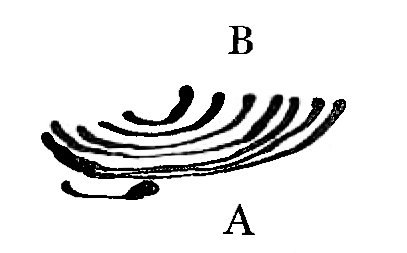To Isaac Anderson-Henry 2 May [1863]1
Hartfield.2
May 2nd. 1863.
My dear Sir,
I have left home for a little change and your kind letter has followed me.—3 You think far too highly of my paper on Linum etc.4 I agree that subject is only beginning. I write now partly to say that I am convinced (but evidence too long) that graduated length of stamens in same flower has no relation to powers of fertilization, at least in most cases.

For scarlet dwarf Pelargonium, if B represents the ordinary graduated stamens, you will find occasionally an additional and abnormal stamen (A) on opposite and lower side of flower. Now the pollen of this one occasional short stamen, I think, very likely would produce dwarf plants.— If you experiment on Pelargonium, I would suggest your looking out for this single stamen.5
I observed fluctuations in length of pistil in Phloxes, but thought it was mere variability.6
If you could raise a bed of seedling Phloxes of any species except P. Drummondii it would be highly desirable to see if two Forms are presented; and I should be very grateful for information and flowers for inspection. I cannot remember, but I know that I had some reason to look after Phloxes.—7
I am very glad to hear that you intend working at Linum.8
I do not know whether you have used microscopes much yet. It adds immensely to interest of all such work as ours, and is indeed indispensable for much work.— Experience, however, has fully convinced me that the use of the Compounds without the simple microscope is absolutely injurious to progress of Natural History (excepting, of course, with Infusoria).9 I have, as yet, found no exception to the rule, that when a man has told me he works with Compounds alone, his work is valueless.
With my best thanks. | My dear Sir, | Yours very faithfully. | C. Darwin.
Footnotes
Bibliography
Beale, Lionel Smith. 1861. How to work with the microscope: a course of lectures on the practical use of the instrument and microscopical manipulation. London: John Churchill.
Beaton, Donald. 1861. Fertilisation of wheat. Journal of Horticulture n.s. 1: 311–13.
Burnett, William A. S. 1992. Darwin’s microscopes. Microscopy: the Journal of the Quekett Microscopical Club 36: 604–27.
Correspondence: The correspondence of Charles Darwin. Edited by Frederick Burkhardt et al. 29 vols to date. Cambridge: Cambridge University Press. 1985–.
Forms of flowers: The different forms of flowers on plants of the same species. By Charles Darwin. London: John Murray. 1877.
LL: The life and letters of Charles Darwin, including an autobiographical chapter. Edited by Francis Darwin. 3 vols. London: John Murray. 1887–8.
ML: More letters of Charles Darwin: a record of his work in a series of hitherto unpublished letters. Edited by Francis Darwin and Albert Charles Seward. 2 vols. London: John Murray. 1903.
‘Two forms in species of Linum’: On the existence of two forms, and on their reciprocal sexual relation, in several species of the genus Linum. By Charles Darwin. [Read 5 February 1863.] Journal of the Proceedings of the Linnean Society (Botany) 7 (1864): 69–83. [Collected papers 2: 93–105.]
Summary
Convinced length of stamens has no relation to powers of fertilisation in many plants.
Suggests experiments on Pelargonium and Phlox.
Advises about use of microscope.
Letter details
- Letter no.
- DCP-LETT-4136
- From
- Charles Robert Darwin
- To
- Isaac Anderson/Isaac Anderson Henry
- Sent from
- Charles Langton, Hartfield
- Source of text
- DAR 145: 3
- Physical description
- C 3pp
Please cite as
Darwin Correspondence Project, “Letter no. 4136,” accessed on 23 April 2024, https://www.darwinproject.ac.uk/letter/?docId=letters/DCP-LETT-4136.xml
Also published in The Correspondence of Charles Darwin, vol. 11


